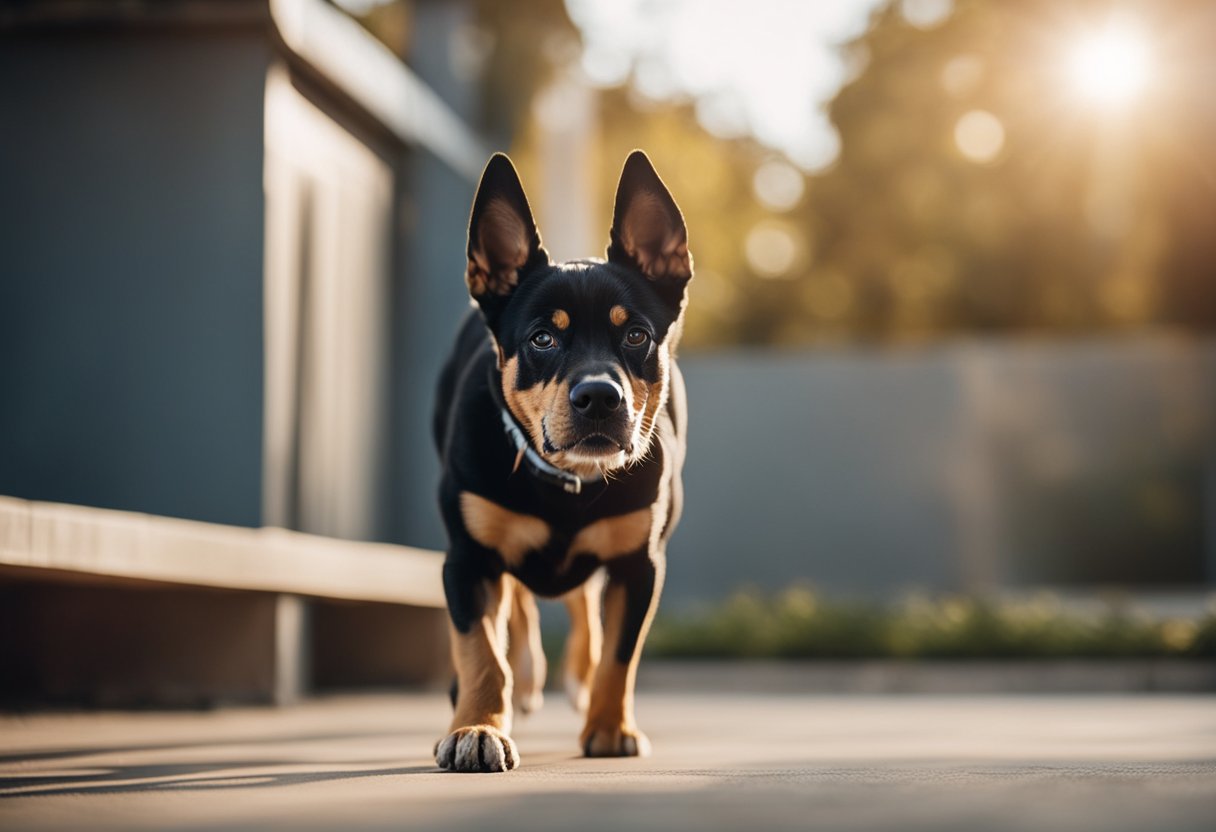I am often asked if dogs can get abs, and the answer is yes, but it’s not quite the same as how humans develop abdominal muscles. Dogs have a different anatomy and physiology than humans, so their abdominal muscles work differently. However, dogs can still have toned abdominal muscles, which can be achieved through exercise and proper nutrition.

While dogs may not have a six-pack like humans, they still have abdominal muscles that play an important role in their overall health and well-being. Strong abdominal muscles can help support a dog’s spine and prevent back problems, as well as improve their posture and balance. Additionally, toned abdominal muscles can improve a dog’s athletic performance and help them maintain a healthy weight.
It’s important to note that not all dogs will develop visible abdominal muscles, as this can depend on factors such as breed, age, and genetics. However, all dogs can benefit from regular exercise and a balanced diet to help maintain a healthy body weight and promote overall muscle tone. So, while dogs may not have the same kind of abs as humans, they can still have strong and healthy abdominal muscles that contribute to their overall health and well-being.
Understanding Dog Anatomy
https://www.youtube.com/watch?v=BetJNf6ME2s&embed=true
As a dog owner, it is important to understand the anatomy of your pet to ensure that they are fit, healthy, and happy. A dog’s anatomy is similar to that of humans, but there are some differences that are important to note. In this section, I will discuss the abdominal muscles in dogs and how they relate to achieving lean muscle mass and a healthy body fat percentage.
Abdominal Muscles in Dogs
The abdominal muscles in dogs are responsible for providing strength, balance, and stability to their posture. The main muscle group in the abdomen is the rectus abdominis, which runs down the center of the dog’s belly. This muscle group is responsible for bending and flexing the spine, as well as providing support to the internal organs.
To achieve a lean and muscular physique, it is important to exercise the rectus abdominis muscle. Some exercises that can help to strengthen this muscle group include sit-ups, leg raises, and planks. However, it is important to note that over-exercising this muscle group can lead to injury and should be done in moderation.
Body Fat and Muscle Mass
Achieving a healthy body fat percentage and lean muscle mass is important for a dog’s overall health and well-being. Dogs that are overweight or obese are at risk for a variety of health problems, including diabetes, heart disease, and joint problems.
To achieve a healthy body fat percentage and lean muscle mass, it is important to provide your dog with a balanced diet and regular exercise. A diet that is high in protein and low in carbohydrates can help to promote lean muscle mass, while regular exercise can help to burn excess fat and build muscle.
It is also important to note that dogs have a layer of fat that is necessary for their overall health. This layer of fat helps to insulate their body and regulate their body temperature. However, it is important to maintain a healthy body fat percentage to ensure that your dog is not at risk for health problems.
In conclusion, understanding the anatomy of your dog is important for their overall health and well-being. By focusing on exercises that strengthen the abdominal muscles and maintaining a healthy body fat percentage, you can help your dog achieve a lean and healthy physique.
Can Dogs Have Visible Abs?
https://www.youtube.com/watch?v=3pUw1WJsXk8&embed=true
As a dog owner, you may have wondered if your furry friend can have visible abs, similar to humans. While it is possible for dogs to have defined abdominal muscles, it depends on several factors, including breed, genetics, age, physical activity, and diet.
Breed and Genetics
Certain breeds, such as Boxers, Rottweilers, Bulldogs, American Pit Bull Terriers, Cane Corsos, Greyhounds, Staffordshire Bull Terriers, and Australian Cattle Dogs, are more likely to have visible abs due to their muscular build. However, genetics also play a significant role in determining if a dog can have a six-pack.
Age and Physical Activity
Age and physical activity are also important factors in determining if a dog can have visible abs. Younger dogs with higher energy levels and stamina are more likely to have defined abdominal muscles. Regular exercise, including core exercises, strength training, and outdoor activities like walking, jogging, hiking, agility training, and swimming, can help dogs build muscle and maintain a healthy weight.
Diet and Nutrition
Diet and nutrition also play a vital role in a dog’s ability to have visible abs. A healthy diet with high-quality protein, healthy fats, and fiber-rich foods can help dogs build muscle and maintain a healthy weight. Protein-rich foods like chicken, fish, and beef can provide essential amino acids to help build and repair muscles. Additionally, supplements like vitamins and minerals can help support a dog’s overall health and well-being.
In conclusion, while it is possible for dogs to have visible abs, it depends on several factors, including breed, genetics, age, physical activity, and diet. As a responsible dog owner, it’s essential to provide your furry friend with regular exercise and a healthy diet to maintain their overall health and well-being.
Exercises for Dog Abs
https://www.youtube.com/watch?v=nnIjeB_P1Nc&embed=true
As a dog owner, I know how important it is to keep our furry friends healthy and fit. Just like humans, dogs can benefit from exercises that target their abs and core muscles. A strong core can improve their balance, stability, and flexibility, leading to a muscular physique and stronger hindquarters and shoulders.
Here are some exercises that you can do with your dog to help them develop their abs:
Sit-ups and Planks
Sit-ups and planks are classic core exercises that can also benefit dogs. For sit-ups, hold a treat above your dog’s head and slowly lift their upper body towards the treat. For planks, have your dog lie down and then lift their body off the ground by supporting their weight on their forearms and hind legs. Hold this position for a few seconds before releasing.
Tug of War and Leg Lifts
Tug of war and leg lifts are also great exercises for dogs. For tug of war, use a sturdy tug toy and encourage your dog to pull on it while you resist. This will engage their core muscles and help them build strength. For leg lifts, have your dog lie down and then lift one of their hind legs off the ground. Hold this position for a few seconds before releasing and repeating with the other leg.
Warm-up and Stretch
Before any exercise, it’s important to warm up and stretch your dog’s muscles to prevent injury. Take your dog for a short walk or jog to get their blood flowing, and then stretch their legs, back, and neck gently. This will help them prepare for the exercises and prevent any muscle strains or sprains.
In conclusion, there are many exercises that you can do with your dog to help them develop their abs and core muscles. By incorporating these exercises into your dog’s routine, you can help them improve their overall health and fitness.
Potential Health Concerns

As with any exercise routine, it’s important to consider potential health concerns when it comes to dogs and abs. While dogs can certainly benefit from core-strengthening exercises, there are some things to keep in mind to ensure their safety and well-being.
Injuries and Recovery
Just like humans, dogs can experience injuries when exercising, particularly if they are new to a routine or are pushing themselves too hard. Common injuries include strains, sprains, and muscle tears. If your dog experiences an injury, it’s important to take them to a veterinarian for proper diagnosis and treatment. Depending on the severity of the injury, your vet may recommend rest, physical therapy, or even surgery.
IBS and Gas
Some dogs may experience gastrointestinal issues when starting a new exercise routine, particularly if they are doing exercises that require a lot of twisting or bending. Symptoms may include bloating, gas, and diarrhea. If your dog experiences these symptoms, it’s important to consult with your vet to rule out any underlying health issues. Your vet may recommend dietary changes or medication to help manage these symptoms.
Imaging and Medication
In some cases, your vet may recommend imaging, such as an ultrasound, to assess your dog’s muscles and joints. This can help identify any potential issues or injuries before they become more serious. Additionally, your vet may recommend medication to help manage pain or inflammation, particularly if your dog experiences an injury.
Overall, with proper management and attention to your dog’s needs, abs exercises can be a safe and effective way to improve their core strength and overall health. As always, it’s important to consult with your vet before starting any new exercise routine to ensure that it is appropriate for your dog’s individual needs.
Conclusion

In conclusion, while dogs can certainly become fit and strong, the question of whether they can develop visible abs similar to humans is still up for debate. Factors such as breed, age, diet, exercise routine, and genetics can all play a role in a dog’s ability to develop a six-pack.
However, it’s important to note that having visible abs is not necessarily an indicator of overall health and fitness in dogs. A lean and muscular body with a strong core and balanced strength is more important than having a visible six-pack.
To help your dog achieve optimal fitness, it’s important to provide them with a balanced and nutritious diet, regular exercise, and a consistent exercise routine that targets their core and overall strength. This can help improve their balance, agility, and overall health.
In the end, while it may be possible for some dogs to develop visible abs, it’s not a necessary or even desirable goal for most pet owners. Instead, focus on helping your dog achieve a healthy and balanced lifestyle that promotes overall strength and fitness.






